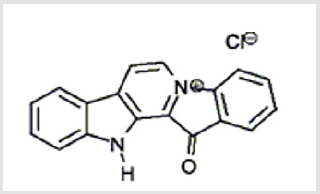Highlights on the Selective CDK4/6 Inhibitors
Introduction
Cyclin-dependent kinases (CDK) are protein kinases of CMGC group, which play an necessary role in the control of the cell cycle, proliferation and transcription. In total there are 21 CDK genes in human genome and 11 of them are called “classical” CDKs. The “classical” ones are responsible for the activation of the cell cycle of quiescent cells and G1/M and G2/S transitions. Various CDKs are involved in different checkpoints of the cells cycle. For example, CDK 4 and 6 initiate the transition from quiescence to proliferation; CDK2 coordinates cell progression from G1 through S-phase, while CDK1 is a universal M-phase promoting factor. Diffrent CDKs also associate with various cyclins: CDK4/6 with cyclin D, CDK2 first with cyclin E and then with cyclin A and CDK1 with cyclin B [1,2]. Increased levels of expression and/or activity (especially CDK4, CDK6 and CDK2) have been observed in many different cancers [3-5]. Therefore, the search for the inhibitors of CDKs has been one of the interests of both academic and industrial scientific communities. To date, more than 30 different CDK small molecule inhibitors have been developed: broad-range inhibitors (such as, olomoucine, roscovitine, kenpaullone, SNS-032, AT7519, AG- 024322, R547), specific inhibitors (such as fascaplysin, ryuvidine, purvalanol A, NU2058, BML-259, SU 9516, P-276–00) and third generation inhibitors (such as dinaciclib). So far, the most hope lies with CDK4/6 specific inhibitors, namely: fascaplysin, LY2835219 and PD-0332991.
Most Recent Research on Selective CDK4/6 Inhibitors
Fascaplysin
Subtance originally isolated from the sponge Fascaplysinopsis bergquist, is a kinase inhibitor selective for CDK4 (IC50 = 0.35μM) and CDK6 (IC50 = 3.4μM) and not selective for the other CDKs or other kinases. (IC50~500 μM) [3,4] and (Figure 1). Couple interesting preclinical studies were performed last year, one of which was lung cancer. Inhibitor showed high activity against Small Cell Lung Cancer (SCLC) (IC50=0.89μM) and Non-Small Cell Lung Cancer (NSCLC) cell lines (IC50 1.15 μM) [6]. The other study on glioblastoma C6 cell line showed that the concentrations as low as 0.005 μM were effective using fascaplysin, and the derivatives (7-phenylfascaplysin, 3-chlorofascaplysin, 3-bromofascaplysin, and 10-bromofascaplysin) were even more effective than unsubstituted fascaplysin [7].
Abemaciclib (LY2835219)
A potent and selective inhibitor of CDK4 (IC50=2 nM) and CDK6 ( IC50=10 nM). Earlier it was shown to be beneficial for patients with metastatic breast cancer [4]. In 2018, several interesting studies were performed using this inhibitor. The in preclinical xenograft mouse of Ewing sarcoma, it was shown that abemaciclib induced quiescence in cell lines via a G1 cell-cycle block. Decreased proliferation as well as reduction of Ki-67, FOXM1 expression and RB phosphorylation was also observed [8]. Combination study in patients with stage 4 NSCLC, showed an acceptable safety profile w in combination with pemetrexed, gemcitabine, or ramucirumab [9]. The clinical study in hormone receptor-positive advanced breast cancer in a special sub-group, called MONARCH 2 and MONARCH 3, showed not only a, efficacy of abemaciclib as a combinatorial therapy, but also the prognostic factors for the diagnostics [10]. Palbociclib (PD-0332991): a highly specific inhibitor of CDK4 (IC50 = 0.011 μM) and CDK6 (IC50 = 0.016 μM), having no activity against a panel of 36 additional protein kinases [3,4] and (Figure 2). This selective CDK4/6 inhibitor is the most studied of all and it showed the most potency of all in clinical trials already in 2012 [11]. The most studies in 2018-2019 were also connected to the clinics, namely Phase I and/or Phase II studies. The combination study of palbociclib, fulvestrant, trastuzumab, and pertuzumab showed a significant effect on the expression of Ki67 at second week of treatment (p<0·0001) and at time of surgery (p=0·013) [12]. The effect was observed in ER, ERBB2, and RB1 in ERBB2-positive and ER-positive breast cancer. The other study demonstrated that palbociclib in combination with letrozole was quite effective as first-line treatment for ER+/HER2- advanced breast cancer showing that DFS probability was 75.0% (90% CI, 61.3%-84.4%) [13]. The study of palbociclib in combination with letrozole or fulvestrant ERBB2-negative breast cancer , called PALOMA 1, 2 and 3, the initial phase II/III studies that led to the U.S. Food and Drug Administration (FDA) approval of palbociclib in metastatic breast cancer, will continued including african american women [14].
The study of palbociclib as sigle agent in adult patients with recurrent RB1-positive glioblastoma demonstrated that palbociclib monotherapy was not an effective treatment, however since patients were heavily pretreated, different selection of treatment could still deserves to be explored [15]. Same story goes for the patients with metastatic urothelial cancer, where palbociclib did not demonstrate substantive activity in selected patients with platinum-refractory metastatic cancer [16]. PALLET trial with palbociclib together with letrozole in ER-positive breast cancer showed that palbociclib together with letrozole significantly enhanced the suppression of malignant cell proliferation (using Ki-67) in primary ER-positive cancer (p< 0.001) as well as complete cell-cycle arrest (p< 0.001) but did not increase the clinical response [17]. Phase I trial using the combination paclitaxel and palbociclib showed safety and clinical benefit in retinoblastoma protein-expressing, advanced breast cancer [18].
Final Remarks
The field of CDK4/6 inhibitor development had seen a significant during past several years. Nevertheless, there is still much room for improvement. Probably combination therapies with CDK4/6 inhibitors could be more promising than monotherapies, therefore more chemotherapeutic agents should be evaluated in combination. On the other hand other targeted drugs, such as inhibitors of other kinases might work together with CDK4/ inhibitors and should be evaluated. So far these inhibitors seem to be very promising and highly researched and used. There is overflowing promise!
Two Cases of 45,X/47,Xxx Turner Mosaicism With Different Growth Patterns Possibly Caused By Different Growth Hormone Therapies-https://biomedres01.blogspot.com/2021/02/two-cases-of-45x47xxx-turner-mosaicism.html
More BJSTR Articles : https://biomedres01.blogspot.com




No comments:
Post a Comment
Note: Only a member of this blog may post a comment.